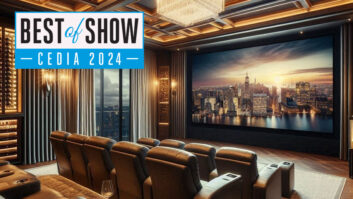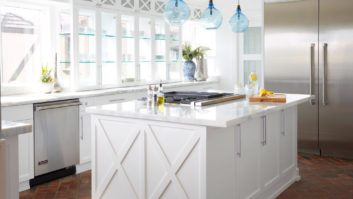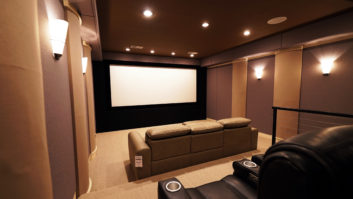This Integration Guide was sponsored by James Loudspeaker and KEF as a supplement to Residential Systems, May 2016
How we listen to music these days has been taken over by tech-driven means, including numerous wireless delivery options with Bluetooth leading the way. It is easy to misread this development as a growing lack of appreciation for loudspeakers as we traditionally know them: floorstanding or in-walls.
Having helped distinguish custom integrators as audio experts for a of couple decades, the maturing in-wall/in-ceiling speaker market (now being arguably driven by the evolving home theater model) is especially vulnerable to talk of extinction when placed alongside modern music-listening habits (defined ever more by audio distribution needs and practices) that have been bolstered by the proliferation of always improving networks. However, manufacturers that have kept this market not only viable but also innovative, beg to differ.

“The Bluetooth speaker category has certainly gained momentum over the past few years with improvements in the overall quantity of sound,” said Jack Hill, marketing director for Sonance. “The mass appeal of the category is undoubtedly due to its low cost, ease of setup, and flexible installation. All of these factors would seemingly spell the demise of traditional in-wall and in-ceiling speakers, [but] Bluetooth speakers suffer from quality and performance limitations.”
Therefore, Hill contended, custom integrators will remain a viable category because the in-wall/in-ceiling speakers they provide deliver the true definition of performance when it comes to distributed audio. “True performance for a customer is only achieved when distributed audio delivers quality sound and smooth, even coverage that is comfortable in a room when entertaining, while delivering amazing sonic clarity,” he said.
Origin Acoustics’ CEO Jeremy Burkhardt is even more emphatic, noting that in-wall speakers “blow away” Bluetooth speakers when it comes to aesthetics and performance. “It’s an unfair comparison,” he said. “By having speakers concealed in the wall, you can make them bigger, louder, and more powerful without expanding the amount of space taken up in a room. In-wall speakers offer savvy homeowners and audiophiles something Bluetooth-enabled speakers just can’t: an immersive, high-fidelity experience without clutter.”

James Loudspeaker’s in-wall/in-ceiling product development efforts focus largely on achieving higher output, lower distortion, and enhanced clarity from smaller form factors, such as in its Small Aperture Series.
Burkhardt’s objection to the comparison is best understood if we draw a line between today’s music-listening habits, which have been heavily influenced by the growing appreciation for and subsequent lower costs of audio distribution, versus the equally rising demand for affordable, yet dynamic, home theater audio solutions.
ELEVATING PERFORMANCE
It is easy to forget that the problems currently associated with Bluetooth and other wireless speaker options are the same ones—sound quality and performance—that plagued in-wall/ceiling speakers when custom integrators began seriously considering them for their high-end projects. Always of aesthetic value, in-wall/ceiling speakers eased a lot of the tension often experienced between interior designers, audiophiles, and the integrator; the discreet factor was always going to be the category’s saving grace and that continues to be true, even as CI manufacturers have elevated their offerings with software tools, improved tweeters and drivers, and more seamless bezels that render many of these speakers nearly invisible. It also helps that the average consumer is growing familiar with object-based audio, which is beginning to reshape the home theater market and force innovation on the audio side of the field.
“The progress in driver design made in the last two decades, primarily advancements in materials and magnetics, has allowed speaker manufacturers to achieve more sound out of smaller, thinner drivers,” said Mike Buratto, product manager, component audio at Klipsch. “Because of this, there is no longer an acoustic compromise when it comes to architectural speakers—the enduser can have a powerful, dynamic, true-to-life listening experience with the clean aesthetics of a custom-installed system.”

Klipsch lays claim to developing the first “horn-loaded in-wall speakers,” an innovation that it now carries through to its THX Certified Professional 7000 and 6000 Series.
Klipsch lays claim to developing the first “horn-loaded in-wall speakers,” an innovation that it now carries through to its THX Certified Professional 7000 and 6000 Series, which Buratto calls a true high-performance home theater system in architectural form factor that “could go toe-to-toe with any box speaker on the market for output, detail, and power.”
Paradigm’s CI Pro and CI Elite Series feature what Justin Bright, director of marketing and digital technology, refers to as “the most compelling technology packages in the category” by integrating the company’s proprietary sound innovations (Active Ridge Technology surrounds and Perforated Phase Aligning tweeter lenses) into its in-wall/ceiling speakers.

Paradigm’s CI Pro and CI Elite Series features proprietary sound innovations such as Active Ridge Technology surrounds and Perforated Phase Aligning tweeter lenses.
“Along with developing hidden speakers that perform like traditional speakers, we’ve developed technology to drive these speakers in a whole-house audio installation with Play-Fi-enabled products like our PW AMP,” Bright said. “Home theater installations that use in-wall or in-ceiling speakers can also take advantage of Wi-Fi streaming, with a new line of AV receivers and pre-processors from Anthem [Paradigm’s sister company], with Play-Fi built-in as well.”
Focusing on performance and aesthetics, SpeakerCraft (under the Core Brands umbrella) also places importance on proprietary technologies, including ARC Tweeter Array found in its AIM Series 2, which elevates midrange frequencies by utilizing the energy created by its multiple tweeters to lower the crossover point. According to Matt Dever, Core Brands’ product manager for audio, the array’s pivoting and rotational mounting allows a user to focus the sweet spot more accurately and reduce reflections off the floor and walls to improve speech intelligibility from midrange frequencies.
“Some will say, ‘We produce a wider sound field, and of course, bigger is better, right?’ But that’s not necessarily true when you consider the ear fatigue that can be brought on by the unwanted reflections,” Dever stated. “So back to the end user—as an industry, we need to deliver products and installations that are as exciting five years after the installation as they were the first day.”
Proficient is developing the new Signature Series, which Keith Marshall, senior vice president of channel management at Core Brands, describes as building upon the company’s achievements with its Signature high-gloss black cabinet loudspeakers and subwoofer.
“For end users, this creates an exciting choice and a step up in sound performance—dealers can now easily explain to their customers that if they want the very best that Proficient has to offer, it’s the Proficient Signature series of loudspeakers,” Marshall added. “And this new choice is with a known and established sub-brand—Signature—that many of them are already using. End users will appreciate Signature’s striking new industrial design, and we’ve matched this design with the high-powered combination of Kevlar woofers, aluminum-dome tweeters, and the strength/rigidity of die-cast speaker baskets for improved woofer linearity.”
The Director Collection from Origin Acoustics, which Burkhardt said was designed from scratch, features larger drivers, smaller footprints, more flexibility, finer materials, lower-profile grilles, wider dispersion, and a faster-to-install tool-less speaker assembly.
“Visibility definitely plays a huge role on this category,” Burkhardt said when asked about influences on the development of in-walls. “Meticulous interior designers are turning their eye to the ceiling and noticing the vents, lighting, and other fixtures, wanting non-intrusive products to complement the room’s design aesthetics. Their specifications become the list of “must haves” in Origin Acoustics, design process.”
Harman recently added two new JBL Synthesis custom loudspeakers, the SCL-3 and SCL-4, that are flush-mount compression driver-based solutions. Considered invisible speakers, the new additions take advantage of patented JBL transducer and waveguide technologies to overcome placement limitations and the appearance of two-channel Hi-Fi or multichannel LCR, surround, and immersive audio overhead channel applications.
“Their wide-coverage patterns (up to 120 by 120 degrees),” said Jim Garrett, director of marketing and product management for Harman Luxury Audio, “high-power handling, big dynamics, and audiophile-grade components deliver performance that exceeds that of a large number of in-room loudspeakers—all from a product that fits in standard 2-by-4 wall construction and includes our visibly unobtrusive zero-bezel magnetically attached grille.”
Sandy Gross, co-founder of GoldenEar Technology, highlighted the company’s Invisa HTR 7000 when discussing its in-ceiling offerings. Originally developed to be a high-performance front main in-ceiling speaker, the Invisa HTR 7000 can be used in both home theater and two-channel applications.
“We have demoed these at CEDIA in a home theater system, and they were so effective that dealers and reviewers thought they were listening to the large floorstanding Triton Ones sitting beneath them,” Gross said. “Then, we found that they were ideal in-ceiling Atmos height speakers. And this year, as the ultimate stealth solution, we showed a complete in-ceiling Atmos system using HTR 7000s. Solutions like this have been dramatically successful in growing the category, as our dealers’ sales have shown.”
In addition to releasing several new products to enhance the category, KEF also has issued high-end THX-certified speakers using aluminum in place of lower-cost plastic for primary listening room and home theater experiences. “KEF is fortunate to have a team of research engineers investigating the physics behind loudspeaker science,” said David Kroll, KEF’s global CI product manager. “This has led to a number of technology breakthroughs. One is our Uni-Q driver technology—with off-axis response as much as 160 degrees to 170 degrees, KEF’s in-ceiling speakers are able to fill a room even when room aesthetics require them to be placed in less-than-ideal locations. This technology also is a perfect match for the acoustics required to create a professional-sounding Atmos Theater.”

James Loudspeaker’s in-wall/in-ceiling product development efforts focus largely on achieving higher output, lower distortion, and enhanced clarity from smaller form factors, such as in its Small Aperture Series.
The BE series of in-wall home theater speakers from James Loudspeaker have been designed to deliver high output and clarity through the use of a beryllium-dome quad-tweeter array engineered into an installer-friendly 4-inch-deep enclosure. These are features that Ted Telesky, chief marketing officer for James, said keeps the category appealing for both integrators and end users.
“Architects, designers, and homeowners all wish to see as little as possible when it comes to audio components and/or loudspeakers in their refined décor,” he added. “At James Loudspeaker, our in-wall/in-ceiling product development efforts focus largely on achieving higher output, lower distortion, and enhanced clarity from smaller form factors that are barely visible once installed. This holds true for our architectural speakers such as the Small Aperture Series, as well as our in-wall theater speakers that must meet the demands of highly dynamic cinematic content.”
Audio distribution should not be ignored as a significant influence on the category. Bose, perhaps one of the most consumer-friendly audio brands around, has created the SoundTouch wireless music system line to deliver an immersive, multi-room experience. With the its SoundTouch SA5 amplifier included, the system powers up to two pairs of speakers with 100 watts per channel and homeowners can use the free SoundTouch app to control each zone individually, or multiple zones at the same time.


With its SA5 amplifier included, the Bose SoundTouch system powers up to two pairs of speakers with 100 watts per channel.
“We’ve also tried to make the choice of in-wall/in-ceiling speakers simple by not overwhelming customers with too many choices,” said Glenn Gomes- Casseres, director of product planning and management. “Our Virtually Invisible line of speakers is easy to understand: two levels of audio performance in two shapes. Each comes with our exclusive Stereo Everywhere technology for even, balanced sound in a room with no hotspots. They’re also easily adaptable to the décor of your home; you can paint over the grilles to match the color of your ceilings or walls.”
The Architectural Series Discreet Opening System from Sonance also pays close attention to the needs of those seeking a stellar audio distribution option by using several small satellite speakers, subwoofers, and DSP amplifiers to provide a discreet, yet consistent aural experience.
“Everyone enjoys the perfect audio level, no matter where they are in the room,” Hill said. “The combination of dedicated subwoofers with a small opening consistent with the satellite speakers ensures an immersive sound experience throughout the space.”
BETTER WITH AGE
A walk through any of our yearly major industry events tells the tale: in-wall and in-ceiling speakers may be a maturing branch of our business, but it is by no means a dying category, with CI speaker manufacturers continuing to invest R&D dollars in improving their offerings. Excitement around object-based audio has proven to be a tremendous innovation stimulant, too, bringing with it a refreshing second boom to the audio segment. Latching on this second wave is critical, while also looking out for what might next inject change in the field.
“To move the category forward, we as manufacturers have to focus on how the end users interact with their music,” Bright said. “In-wall and in-ceiling speakers that aren’t connected to sources of music that are easy to access will limit their usefulness. Thankfully, there are many new methods, like Play-Fi, to connect great music to great speakers. The need to seamlessly integrate sound into a living space will allow custom integrators to offer the best sound solutions for years to come.”







